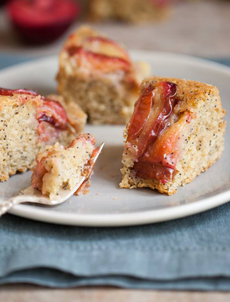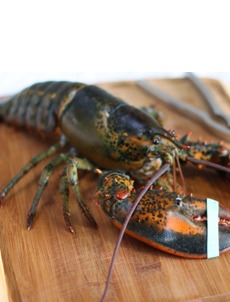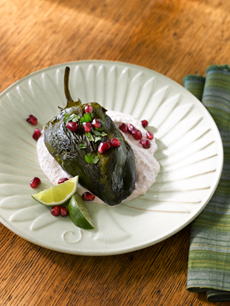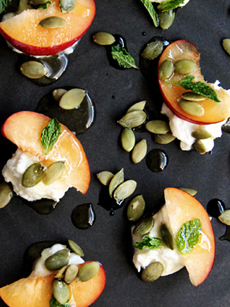
[1] Summer plums with creamy burrata: a great union (photo © Bee Raw).
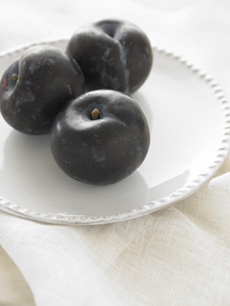
[2] In addition to (or instead of) plums, you can add other stone fruits: apricots, cherries, nectarines or peaches (photo © Washington State Fruit Commission).
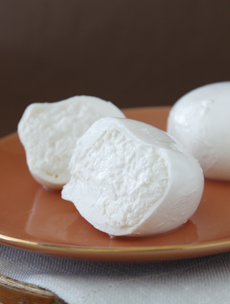
[3] Love that burrata! (photo by Elvira Kalviste | © THE NIBBLE).
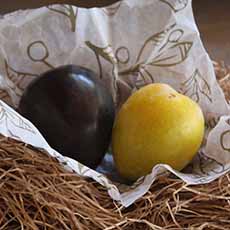
[4] Pluots, a cross of plums and apricots (photos © Frog Hollow Farm).

[5] Ripe black and green pluots (photo © Sid Wainer).
|
|
We’re always in the mood for burrata. After making grilled grapes with burrata a few days ago, we whipped this up yesterday.
This recipe combines fresh summer plums, creamy burrata cheese, pepitas (pumpkin seeds) and honey into a dish that’s called a “salad,” but consider it a cheese course dessert.
The contrasting textures, flavors, and colors are what we should aim for in every dish.
The recipe is from Bee Raw Honey, which used its star thistle honey for extra special flavor. You can substitute pluots for the plums.
Star thistle honey, harvested from wild star thistle plants in Colorado, is thick and creamy with hints of cinnamon. It also pairs well with apples—drizzled over apple slices or added to baked or roasted apples.
RECIPE: PLUM SALAD WITH BURRATA, PEPITAS & HONEY
Ingredients For 2-3 Servings
6 ounces burrata cheese
3 plums
A a few tablespoons extra virgin olive oil
A a few tablespoons star thistle or other honey
1/4 cup unsalted pepitas (pumpkin seeds)
A few sprigs fresh mint
Preparation
1. BREAK the burrata into about 24 bite-sized pieces,
2. PIT and slice plums into 8 slices each, set aside.
3. LAY out four salad or two dinner plates. Divide the burrata pieces equally among plates. Top the Burrata with plum slices. Dot plates with olive oil and honey, covering cheese and fruit with each.
4. SCATTER each plate with pumpkin seeds and mint; serve immediately.
WHAT IS BURRATA?
Somewhere around 1920 in the town of Andria in the Puglia region of southern Italy, a member of the Bianchini family figured out how to repurpose the curds from mozzarella making.
Burrata was born, a ball of mozzarella filled with creamy, ricotta-like curds. Cut into the ball and the curds ooze out: a wonderful marriage of flavors and textures.
Their burrata was premium priced, made in small amounts, and remained the delight of the locals for some thirty years.
In the 1950s, some of the local cheese factories began to produce burrata, and more people discovered its charms. Only in recent years, thanks to more economical overnighting of refrigerated products, did we find it in New York City’s finest cheese shops.
Now, you can find domestic burrata anywhere there’s a Trader Joe’s. It’s just as delicious as the imports (in fact, American-made burrata is so good that there’s no longer a need to import it).
WHAT’S A PLUOT?
Pluots, plumcots and apriums are all hybrid combinations of plums and apricots, but with different percentages of each parent fruit’s DNA. The names are trademarked by their respective breeders.
They were developed to present the best qualities of both fruits. For the consumer, this means more sweetness and juiciness; for the grower, easier to grow, harvest, and ship.
A plumcot is 50% plum/50% apricot. Developed by Luther Burbank in the 1920s, it is sweeter than either parent.
The pluot, also known as a “dinosaur egg” because of its speckled skin, was created by a California fruit breeder who wanted to improve on the plumcot.
Pluot vs. plumcot: A pluot, sweeter than a plumcot, is primarily plum, with a range from 60% plum/40% apricot to 75% plum/25% apricot spanning more than 25 varieties. Because of the percentage of genes, it has the flavor of a plum but the mouthfeel of the apricot. Pluots have a higher sugar content and a more complex flavor profile than either a plum or an apricot.
An aprium is the reverse of the pluot: a mix of 70% apricot/30% plum, though it can vary, as long as it is 60% apricot or more. It looks like an apricot, but is sweeter than either an apricot or a plum.
You’re most likely to find these specialty stone fruits at a farmers market.
If you don’t see them, ask!
|
